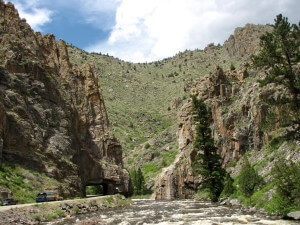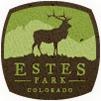Latest News

What’s In a Name
A History of the Cache La Poudre River by Morgan Mayo
Juniper and silver sage cascading down long red riverbanks. The shadow of spruce trees falling across dark water, flowing over lichen covered boulders, disappearing over drops and around bends in a tumult of white. Craggy grey canyon walls against a pale blue sky, all ablaze at sunset. Dark hills covered in ragged rocks. Lush grasses blowing in a summer wind beneath a ghostly white moon.
What do you call a place like that?
How do you give a wild river, flowing older than time, a name?
Today we call it the Cache La Poudre River. It begins in the peaks of the Rocky Mountains along the Continental Divide; winds its way through the Roosevelt National Forest, the city of Fort Collins and eventually merges with the South Platte River near Greeley, Colorado. It flows a total of 76 miles and drops 7,000 feet in the process.
“Cache La Poudre” is French for “where the powder is hidden”. The name came about when trappers for the American Fur Company were stranded in the canyon during a snowstorm. In order to lighten their load and make it to their destination in Wyoming; they had to bury much of their cargo including several barrels of gun powder. The next spring they returned and found that all their cargo was still intact, where they had hidden it.

Photo courtesy of Fort Collins Museum & Discovery Science Center
But the Poudre has been a river of many different people and many different names throughout history. In the letters of a military captain and explorer stationed in the area in 1820, it is referred to as “Pateros Creek”. The Captain said it was named after a Frenchman who lost his way along the winding river and then wandered for twenty days without food.
In 1840, the river was also widely referred to as “Piteux” which is French for Piteous. It achieved this name after a band of French trappers left a young man behind to watch after their trap line over winter. When they returned the following spring they found the man wandering “piteously” along the banks of the river, his clothes in shreds, completely insane from the isolation of the canyon in winter.
And then there was “Mini Luzahan”. Perhaps the most accurate of all the names the river has worn throughout the years, it means “Swift Current” in Sioux.
If there is anything that all the names of the Poudre River have in common, it’s that they describe a place that is at once savage and beautiful, isolated and tranquil.
The words Poudre Canyon instantly inspire images of hidden trails meandering through meadows filled with wildflowers; spring snows melting into the quiet rush of a pristine river. However, for centuries the Canyon and the river have had utilitarian purposes beyond beauty.
Evidence of Native American settlement in the Canyon can be seen through the left over rock shelters, burial sites, and fire hearths nestled in hidden corridors near the river. Gold mining, logging, and railroad construction resulted in permanent settlements in Poudre Canyon in the mid-1800’s. Gold mining met with limited success, as ghost towns such as Manhattan and Old Poudre City continue to attest to today. Yet, there are whisperings that a 19th century bandit’s hoard of panned gold and stolen treasures still remains hidden in some shady grove deep within the Poudre Canyon. Imagine the happy hiker, climber or rafter that happens to stumble upon that secret.

Early Rafting on the Poudre River
In addition to failures in mining, efforts to construct a railroad track through the Canyon were also abandoned. However, many of the original railroad grades eventually served as a foundation during the construction of Highway 14, which continues to snake its way alongside the river today. The construction of this highway gave outdoor enthusiasts greater access to the area and private whitewater rafting trips on the Poudre became immensely popular in the 1950’s.
An important and special milestone in the Poudre River’s history occurred in 1986 when it was designated as Colorado’s first and only Wild and Scenic River. While 46 miles remain open for recreational use, 30 miles of the river are completely wild. In addition, certain restrictions limit the amount of rafting trips that are allowed to go down in a day. Thus, any rafting trip you take with Mountain Whitewater ensures a level of peaceful isolation in nature and a total escape from the hectic, crowded daily grind.
The Poudre River has had a long, tumultuous and at times tragic history. Yet, the moment the shadow of those canyon walls falls across your shoulders it feels as though you’ve entered some furtive world where time stands still. You see a river wound round boulders as deeply as a vein pulsing blood through some pre-historic giant, whose sleeping form has been mistaken for mountains all these years. It is a Canyon torn between light and shadow, the quiet whisper of a breeze passing through the branches of a Cottonwood against the loud crashing cacophony of swirling rapids. It is a place for lost people, lost secrets and lost treasures. Let Mountain Whitewater introduce you to this un-spoilt world so that you can re-discover them.

















